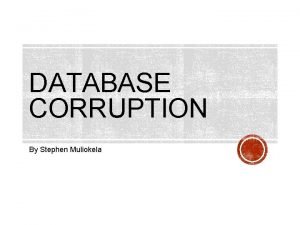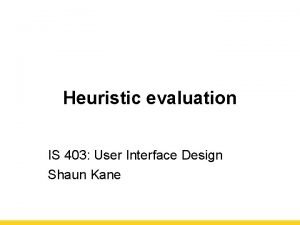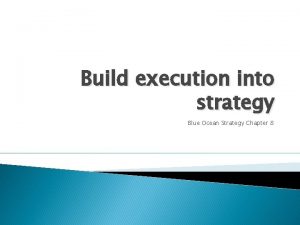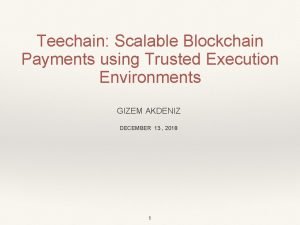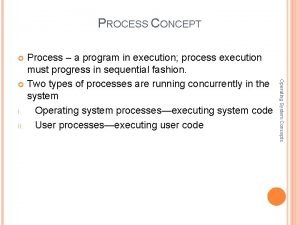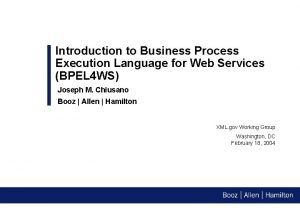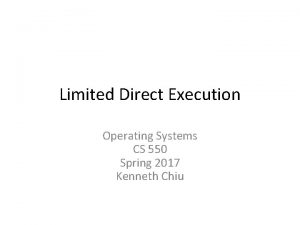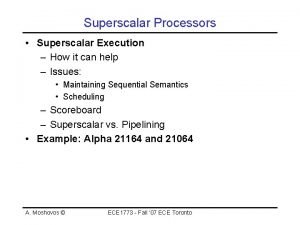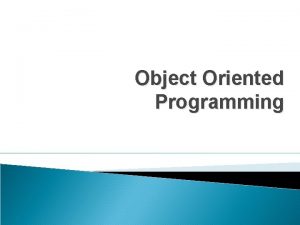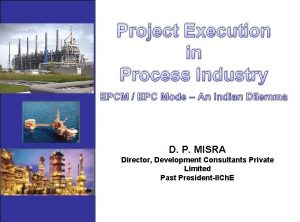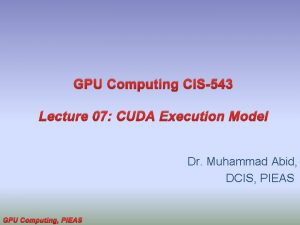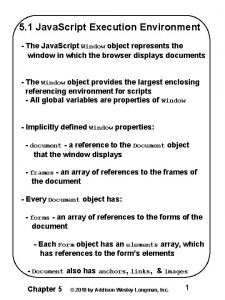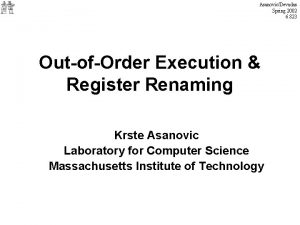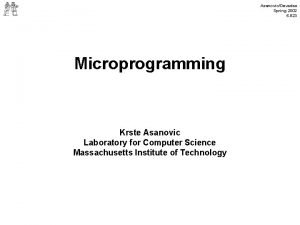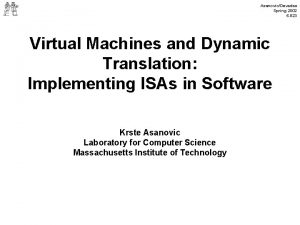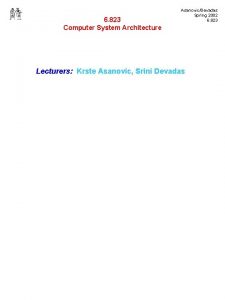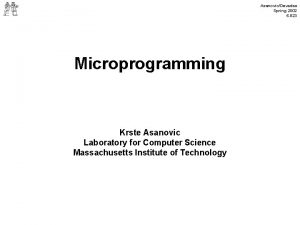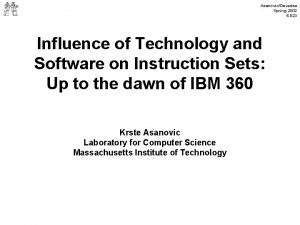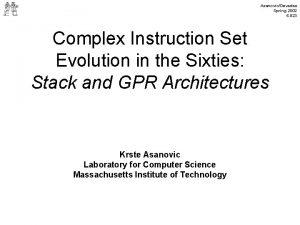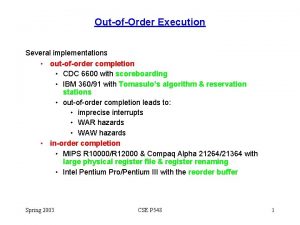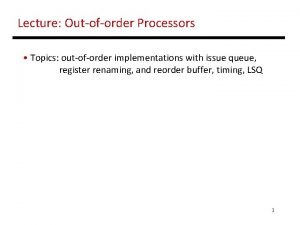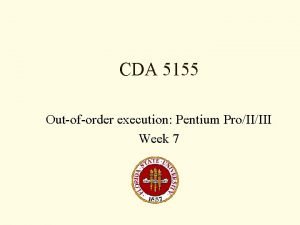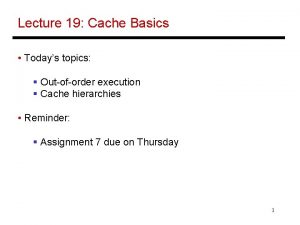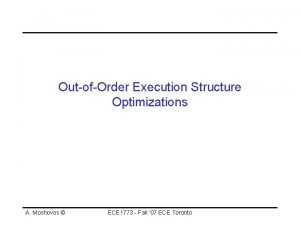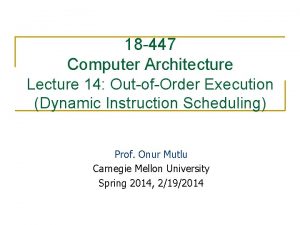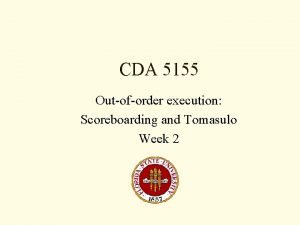AsanovicDevadas Spring 2002 6 823 OutofOrder Execution Register

![Asanovic/Devadas Spring 2002 6. 823 Scoreboard for In-order Issue Busy[unit#] : a bit-vector to Asanovic/Devadas Spring 2002 6. 823 Scoreboard for In-order Issue Busy[unit#] : a bit-vector to](https://slidetodoc.com/presentation_image_h2/0b95550d5204091ab96ec6da4a335b91/image-2.jpg)


























- Slides: 28

Asanovic/Devadas Spring 2002 6. 823 Out-of-Order Execution & Register Renaming Krste Asanovic Laboratory for Computer Science Massachusetts Institute of Technology
![AsanovicDevadas Spring 2002 6 823 Scoreboard for Inorder Issue Busyunit a bitvector to Asanovic/Devadas Spring 2002 6. 823 Scoreboard for In-order Issue Busy[unit#] : a bit-vector to](https://slidetodoc.com/presentation_image_h2/0b95550d5204091ab96ec6da4a335b91/image-2.jpg)
Asanovic/Devadas Spring 2002 6. 823 Scoreboard for In-order Issue Busy[unit#] : a bit-vector to indicate unit’s availability. (unit = Int, Add, Mult, Div) These bits are hardwired to FU's. WP[reg#] : a bit-vector to record the registers for which writes are pending Issue checks the instruction (opcode dest src 1 src 2) against the scoreboard (Busy & WP) to dispatch FU available? not Busy[FU#] RAW? WP[src 1] or WP[src 2] WAR? cannot arise WAW? WP[dest]

Out-of-Order Dispatch ALU IF ID Asanovic/Devadas Spring 2002 6. 823 Mem WB Issue Fadd Fmul • Issue stage buffer holds multiple instructions waiting to issue. • Decode adds next instruction to buffer if there is space and the instruction does not cause a WAR or WAW hazard. • Any instruction in buffer whose RAW hazards are satisfied can be dispatched (for now, at most one dispatch per cycle). On a write back (WB), new instructions may get enabled.

Asanovic/Devadas Spring 2002 6. 823 Out-of-Order Issue: an example latency 1 1 LD F 2, 34(R 2) 2 LD F 4, 45(R 3) 3 MULTD F 6, F 4, F 2 3 4 SUBD F 8, F 2 1 5 DIVD F 4, F 2, F 8 4 6 ADDD F 10, F 6, F 4 1 In-order: Out-of-order: long 1 2 4 3 5 6 1 (2, 1). . . 2 3 4 4 3 5. . . 5 6 6 1 (2, 1) 4 4. . . 2 3. . 3 5. . . 5 6 6 Out-of-order did not allow any significant improvement !

Asanovic/Devadas Spring 2002 6. 823 How many Instructions can be in the pipeline Which features of an ISA limit the number of instructions in the pipeline? Which features of a program limit the number of instructions in the pipeline?

Overcoming the Lack of Register Names Asanovic/Devadas Spring 2002 6. 823 Number of registers in an ISA limits the number of partially executed instructions in complex pipelines Floating Point pipelines often cannot be kept filled with small number of registers. IBM 360 had only 4 Floating Point Registers Can a microarchitecture use more registers than specified by the ISA without loss of ISA compatibility ? Robert Tomasulo of IBM suggested an ingenious solution in 1967 based on on-the-fly register renaming

Asanovic/Devadas Spring 2002 6. 823 Instruction-Level Parallelism with Renaming latency 1 1 LD F 2, 34(R 2) 2 LD F 4, 45(R 3) 3 MULTD F 6, F 4, F 2 3 4 SUBD F 8, F 2 1 5 DIVD F 4’, F 2, F 8 4 6 ADDD F 10, F 6, F 4’ 1 In-order: Out-of-order: long 1 2 4 3 X 5 1 (2, 1). . . 2 3 4 4 (5, 3). . . 5 6 6 1 (2, 1) 4 4 5. . . 2 (3, 5) 3 6 6 Any antidependence can be eliminated by renaming ⇒ additional storage Can it be done in hardware? yes! 6

Register Renaming ALU IF ID Asanovic/Devadas Spring 2002 6. 823 Mem WB ROB Fadd Fmul • Decode does register renaming and adds instructions to the issue stage reorder buffer (ROB). ⇒ renaming makes WAR or WAW hazards impossible • Any instruction in ROB whose RAW hazards have been satisfied can be dispatched. ⇒ Out-of order or dataflow execution

Asanovic/Devadas Spring 2002 6. 823 Renaming & Out-of-order Issue An example Renaming table p data Reorder buffer Ins# use exec op p 1 src 1 p 2 src 2 t 1 t 2. . . F 1 F 2 F 3 F 4 F 5 F 6 F 7 F 8 data / ti 1 2 3 4 5 6 LD LD MULTD SUBD DIVD ADDD F 2, F 4, F 6, F 8, F 4, F 10, 34(R 2) 45(R 3) F 4, F 2, F 6, F 2 F 8 F 4 • When are names in sources replaced by data? • When can a name be reused?

Data-Driven Execution Asanovic/Devadas Spring 2002 6. 823 Renaming table & reg file Reorder buffer Replacing the tag by its value is an expensive operation Ins# use exec Load Unit FU op p 1 src 1 FU p 2 src 2 t 1 t 2. . tn Store Unit < t, result > • Instruction template (i. e. , tag t) is allocated by the Decode stage, which also stores the tag in the reg file • When an instruction completes, its tag is deallocated

Asanovic/Devadas Spring 2002 6. 823 Simplifying Allocation/Deallocation Reorder buffer Ins# use exec op p 1 src 1 p 2 src 2 ptr 2 next to deallocate prt 1 next available Instruction buffer is managed circularly • When an instruction completes its “use” bit is marked free • ptr 2 is incremented only if the “use” bit is marked free t 1 t 2. . . tn

Asanovic/Devadas Spring 2002 6. 823 IBM 360/91 Floating Point Unit R. M. Tomasulo, 1967 data distribute instruction templates by functional units load buffers (from memory) instructions p data . . . p data Addr Floating Point Reg p data Mult < t, result > store buffers (to memory) p data Common bus ensures that data is made available immediately to all the instructions waiting for it

Effectiveness? Renaming and Out-of-order execution was first implemented in 1969 in IBM 360/91 but did not show up in the subsequent models until mid-Nineties. Why ? Reasons 1. Exceptions not precise! 2. Effective on a very small class of programs One more problem needed to be solved Asanovic/Devadas Spring 2002 6. 823

Precise Interrupts Asanovic/Devadas Spring 2002 6. 823 It must appear as if an interrupt is taken between two instructions (say Ii and Ii+1) • the effect of all instructions up to and including Ii is totally complete • no effect of any instruction after Ii has taken place The interrupt handler either aborts the program or restarts it at Ii+1.

Effect on Interrupts Out-of-order Completion 1 2 3 4 5 6 LD LD MULTD SUBD DIVD ADDD f 6, f 2, f 0, f 8, f 10, f 6, 45(r 3) f 2, f 6, f 0, f 8, f 4 f 2 f 6 f 2 Out-of-order comp 1 2 2 3 1 4 3 5 5 4 6 6 restore f 10 Consider interrupts Precise interrupts are difficult to implement at high speed - want to start execution of later instructions before exception checks finished on earlier instructions Asanovic/Devadas Spring 2002 6. 823

Exception Handling (In-Order Five-Stage Pipeline) PC Inst. Mem D Select PC Address Handler Exceptions Exc Pc D PC Kill F D Stage Decode E Illegal Opcode + Overflow Exc E Kill D Stage M PC E Exc M Kill E Stage Asanovic/Devadas Spring 2002 6. 823 Commit Point Data Mem W Kill Data Address Exceptions Writeback PC M Asynchronous Interrupts • Hold exception flags in pipeline until commit point (M stage) • Exceptions in earlier pipe stages override later exceptions • Inject external interrupts at commit point (override others) • If exception at commit: update Cause and EPC registers, kill all stages, inject handler PC into fetch stage Cause EPC

Asanovic/Devadas Spring 2002 6. 823 Phases of Instruction Execution PC I-cache Fetch Buffer Issue Buffer Func. Units Result Buffer Arch. State Fetch: Instruction bits retrieved from cache. Decode: Instructions placed in appropriate issue stage buffer (sometimes called “issue” or “dispatch”) Execute: Instructions and operands sent to execution units (sometimes called “issue” or “dispatch”). When execution completes, all results and exception flags are available. Commit: Instruction irrevocably updates architectural state (sometimes called “graduation” or “completion”).

In-Order Commit for Precise Exceptions Asanovic/Devadas Spring 2002 6. 823 • Instructions fetched and decoded into instruction reorder buffer in-order • Execution is out-of-order (⇒ out-of-order completion) • Commit (write-back to architectural state, regfile+memory) is in-order Temporary storage needed to hold results before commit (shadow registers and store buffers) In-order Fetch In-order Out-of-order Decode Commit Reorder Buffer Kill Inject handler PC Execute Exception?

Asanovic/Devadas Spring 2002 6. 823 Extensions for Precise Exceptions Instruction reorder buffer Inst# use exec op p 1 src 1 p 2 src 2 pd dest data cause ptr 2 next to commit ptr 1 next available • add <pd, dest, data, cause> fields in the instruction template • commit instructions to reg file and memory in program order ⇒ buffers can be maintained circularly • on exception, clear reorder buffer by resetting ptr 1=ptr 2 (stores must wait for commit before updating memory)

Rollback and Renaming Asanovic/Devadas Spring 2002 6. 823 Register File (now holds only committed state) t 1 t 2. . tn Reorder buffer Load Unit FU FU FU Store Commit Unit < t, result > Register file does not contain renaming tags any more. How does the decode stage find the tag of a source register?

Asanovic/Devadas Spring 2002 6. 823 Renaming Table r 1 Rename r 2 Table ti vi Register File t 1 t 2. . tn Reorder buffer Load Unit FU FU FU Store Commit Unit < t, result > Renaming table is like a cache to speed up register name look up (rename tag + valid bit per entry). It needs to be cleared after each exception taken. When else are valid bits cleared?

Asanovic/Devadas Spring 2002 6. 823 Effect of Control Transfer on Pipelined Execution Control transfer instructions require insertion of bubbles in the pipeline. The number of bubbles depends upon the number of cycles it takes • to determine the next instruction address, and • to fetch the next instruction

Branch penality Next fetch started PC I-cache Fetch Buffer Issue Buffer Func. Units Branch executed Decode Execute Result Buffer Commit Arch. State Asanovic/Devadas Spring 2002 6. 823

Asanovic/Devadas Spring 2002 6. 823 Branch Penalties in Modern Pipelines Ultra. SPARC-III instruction fetch pipeline stages (in-order issue, 4 -way superscalar, 750 MHz, 2000) PC Generation/Mux Fetch Decode A P F B I J R E Instruction Fetch Stage 1 Instruction Fetch Stage 2 Branch Address Calc/Begin Decode Complete Decode Steer Instructions to Functional units Register File Read Integer Execute Remainder of execute pipeline (+another 6 stages) Branch penalty: Cycles? ____ Instructions? _____

Asanovic/Devadas Spring 2002 6. 823 Average Run-Length between Branches Average dynamic instruction mix from SPEC 92: SPECint 92 SPECfp 92 ALU 39 % 13 % FPU Add 20 % FPU Mult 13 % load 26 % 23 % store 9% 9% branch 16 % 8% other 10 % 12 % SPECint 92: compress, eqntott, espresso, gcc , li SPECfp 92: doduc, ear, hydro 2 d, mdijdp 2, su 2 cor What is the average run length between branches?

Asanovic/Devadas Spring 2002 6. 823 Reducing Control Transfer Penalties Software solution • loop unrolling Increases the run length • instruction scheduling Compute the branch condition as early as possible (limited) Hardware solution • delay slots replaces pipeline bubbles with useful work (requires software cooperation) • branch prediction & speculative execution of instructions beyond the branch

Branch Prediction Motivation: branch penalties limit performance of deeply pipelined processors Modern branch predictors have high accuracy (>95%) and can reduce branch penalties significantly Required hardware support: Prediction structures: branch history tables, branch target buffers, etc. Mispredict recovery mechanisms: • In-order machines: kill instructions following branch in pipeline • Out-of-order machines: shadow registers and memory buffers for each speculated branch Asanovic/Devadas Spring 2002 6. 823

Asanovic/Devadas Spring 2002 6. 823 DLX Branches and Jumps Instruction BEQZ/BNEZ J JR Taken known? After Reg. Fetch Always Taken Must know (or guess) both target address and whether taken to execute branch/jump. Target known? After Inst. Fetch After Reg. Fetch
 Filter if
Filter if Escala abnt
Escala abnt Norma din 823
Norma din 823 Spring summer fall winter and spring cast
Spring summer fall winter and spring cast Spring autumn winter
Spring autumn winter Riverside permit portal
Riverside permit portal Balanced scorecard execution
Balanced scorecard execution Contoh inisiasi proyek sistem informasi
Contoh inisiasi proyek sistem informasi Direct and manage project execution
Direct and manage project execution Organizational hurdles
Organizational hurdles Zach anders
Zach anders Heuristic evaluation of user interfaces
Heuristic evaluation of user interfaces A mob's illegal seizure and execution of a person
A mob's illegal seizure and execution of a person Build execution into strategy
Build execution into strategy Teechain
Teechain Various addressing modes of 8086 microprocessor
Various addressing modes of 8086 microprocessor A process is a program in execution
A process is a program in execution Business process execution language for web services
Business process execution language for web services A_______ bridges the specification gap between two pls.
A_______ bridges the specification gap between two pls. Limited direct execution protocol
Limited direct execution protocol The execution yue minjun
The execution yue minjun Superscalar execution
Superscalar execution Java applications begin execution at method
Java applications begin execution at method Lstk vs epc
Lstk vs epc The secrets to successful strategy execution
The secrets to successful strategy execution Cuda
Cuda The process of recruiting and retaining capable employees
The process of recruiting and retaining capable employees Javascript execution environment
Javascript execution environment Mary queen of scots execution lesson
Mary queen of scots execution lesson
